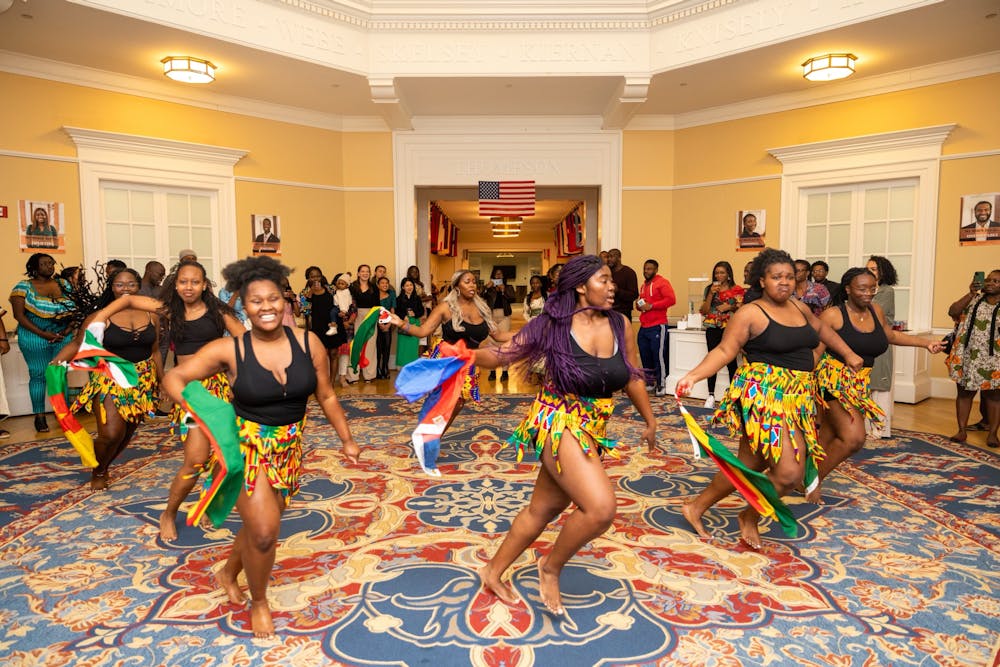With nearly 20 dance teams on Grounds, it is safe to say that the students of U.Va. know how to bust a move. From ballroom to bachata, these teams represent a wide variety of dance styles and levels, teaching those who are new to dance and providing an outlet for those who have danced for years.
Several groups occupy a specific niche, centered on dances from various global cultures. These groups call students of all backgrounds to immerse themselves in salsa, K-pop, Bollywood and more. Three such dance teams — K-Edge Dance Crew, Afro-Hoos and Virginia di Shaan — opened up about their explorations of culture and community through dance.
Since 2015, K-Edge has championed the University’s K-pop scene — whether the team is performing at U.Va. CultureFest, representing the University at K-pop competitions or simply practicing with their friends. Jennie Kang, K-Edge President and third-year Engineering student, said that the most important part of the K-Edge experience is the camaraderie surrounding dance, even during auditions.
“Everyone is cheering for you and singing the song [you dance to],” Kang said. “Everyone is really passionate about what they’re doing, and everyone definitely has shared common interests like K-pop.”
K-Edge provides dancers on Grounds with their own K-pop idol experience even before they join the squad. The group focuses on making sure that its members can dance in both boy group and girl group styles, showing the team’s “ability to do a range.”
Thus, K-Edge challenges its members to do the best they can from the start of their membership, a driving and uniting force behind the K-pop team.
Kang’s love for K-Edge also stems from the club’s appreciation for Korean culture. Having moved from Korea at age 15, Kang said that K-Edge has allowed her to reconnect with her culture.
“I guess [K-pop] is so engraved in my culture that when I started listening to music, I probably started listening to K-pop,” Kang said, “and it’s really amazing for me as a Korean to see how Korean culture has become such a major thing in many countries.”
Afro-Hoos is another team with thrilling opportunities to explore cultural identity through performance. JaNiece Smith, second-year College student, opened up about joining this women’s Afrobeats dance team and meeting a supportive community of Black women.
Smith grew up in a predominantly white neighborhood where she did not know many other Black girls. Since joining Afro-Hoos, she has been able to gain confidence in being a Black woman in a predominantly white institution and hear different perspectives on issues that the Black community faces.
“[Afro-Hoos] is very much about uplifting Black women,” Smith said. “I hope every Black woman, man … or any minority who feels like they don’t have the confidence to show their culture gets out there.”
Afro-Hoos also exposed Smith to African culture, including Afrobeats artists and the influence of African music in Black American music. Smith said she learned that African music has made an impact on everything from hip-hop dance moves to the music of pop stars like Beyonce. When the Afro-Hoos perform at the Organization for African Students’ Africa Day or at local Charlottesville venues, they lead their audiences through a musical tour of African culture — a culmination of all the dance prowess and cultural knowledge Smith has gained herself as an Afro-Hoo.
Dance can also be a way of learning about other people’s cultures, as revealed by Akaash Kamdar, a member of Virginia di Shaan and fourth-year Commerce student. The dance team features the North Indian bhangra dance style, so Kamdar, being from Gujarat, reflected upon his newfound understanding of North Indian culture through the language, props and dance moves.
“There’s a larger agricultural presence in North India, so some of the steps will be focused on farming culture,” Kamdar said. “Small things like that you just learn along the way.”
Virginia di Shaan competes in regional and national bhangra competitions, placing first in last year’s Naach Di Cleveland competition. The team practices at least 12 hours a week, which only strengthens their sense of community.
“[Virginia di Shaan] just becomes a family because you all share the same passion of dance and you all spend so much time together that you create that community yourself,” Kamdar said. “That feeling gets passed down every year and it’s the best part of [Virginia di Shaan], and now after being on the team for four years, it still is.”
Cultural dance teams have established themselves as essential elements of the University because they meet students at the intersection between community and cultural exploration. Dance becomes a vehicle through which students reunite with their home cultures, reconcile with their diasporic cultures or navigate a whole new culture, all while dancing and cheering alongside their friends.







